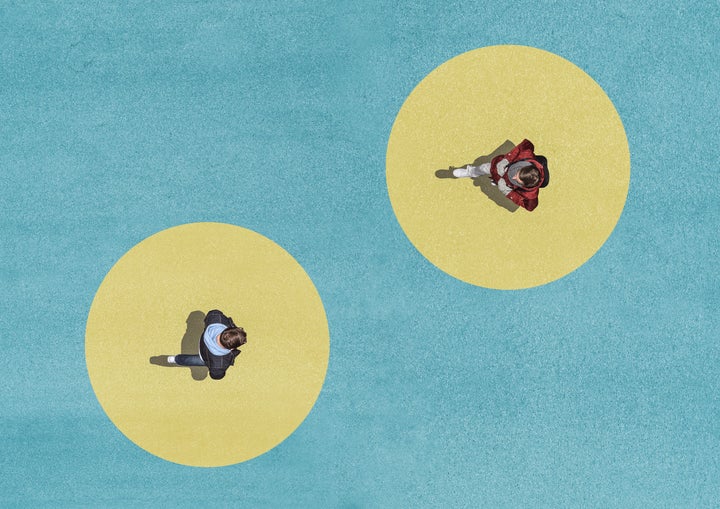We’re here to guide you through the coronavirus lockdown. Sign up to the Life newsletter for daily tips, advice, how-tos and escapism.
Keeping at least one metre away from others lowers the risk of coronavirus transmission, a new study suggests – but distances of two metres are even more effective.
Researchers found that keeping a distance of more than one metre from other people was associated with a much lower risk of infection compared with less than one metre.
The risk of infection when people stood more than a metre away from an infected individual was 3%, whereas if they stood within a metre of someone with Covid-19, the risk of infection was 13%.
But modelling suggests for every extra metre further away a person stands from an infected individual – up to three metres – the risk of infection or transmission may halve, according to the analysis published in The Lancet journal.
Professor Holger Schunemann from McMaster University in Canada, who co-led the research, told Time: “What this evidence suggests is that two metres, or 6.7 feet, appears that it might be more protective than one metre or three feet.”
In the UK, people are advised to keep two metres from others, but there have been calls to reduce this to 1.5 metres – like in Germany – to help the hospitality sector reopen.
Places such as theatres and entertainment venues could be hit hard by the two-metre rule, which would restrict the number of people allowed inside.
The World Health Organisation (WHO) recommends people maintain a distance of at least one metre between each other.
Firstly, how does coronavirus spread?
Covid-19 can spread from person to person through small droplets from the nose or mouth when a person coughs, sneezes, exhales or speaks. These droplets land on objects and surfaces around the person, according to WHO.
We can catch the virus by touching these objects or surfaces, then touching our eyes, nose or mouth. We can also become infected if we breathe in droplets from someone with the virus who coughs out or exhales even smaller droplets (known as aerosols).
Experts agree the larger droplets from a sneeze or cough will fall to the ground within six feet, which is why the 2m social distancing rule is in place. But it’s unclear how far aerosols could travel. What we do know is that aerosols can travel easily in the air due to how small they are, potentially carrying viral content quite some distance from where they originated.
Dr. Donald Milton, who studies bioaerosols at the University of Maryland School of Public Health, suggested to the New York Times that even without the launching power of a sneeze, “air currents could carry a flow of aerosol sized virus particles exhaled by an infected person 20 feet or more away”.
Whether they could actually infect someone at such distances is another story.

What else helps reduce the spread?
For the latest study published in The Lancet journal, researchers looked at data from nine studies across Sars, Mers and Covid-19, including 7,782 participants.
Keeping at least one metre from other people, as well as wearing face coverings and eye protection, in and outside of healthcare settings, could be the best way to reduce the chance of viral infection or transmission of Covid-19, they said.
Thirteen studies focusing on eye protection found that face shields, goggles, and glasses were associated with lower risk of infection, compared with no eye covering. They found that the risk of infection or transmission when wearing eye protection was 6%, and 16% when not wearing eye protection.
Evidence from 10 studies also found similar benefits for face masks in general, with risk of infection or transmission when wearing a mask 3%, and 17% when not wearing a mask.
For healthcare workers, N95 and other respirator-type masks might be associated with a greater protection from transmission than surgical masks or similar. For the general public, face masks are also probably associated with protection, even in non-healthcare settings, the researchers said.
Prof Schunemann said: “Our findings... provide the currently best available evidence on the optimum use of these common and simple interventions to help ‘flatten the curve’ and inform pandemic response efforts in the community.”
Researchers said that none of these interventions – even when properly used and combined – give complete protection from infection. They noted the certainty of the evidence around face masks and eye protection is low.
The authors said their findings have important implications for the current pandemic, and future waves, by informing disease models, and standardising the definition of who has been “potentially exposed” for contact tracing.
